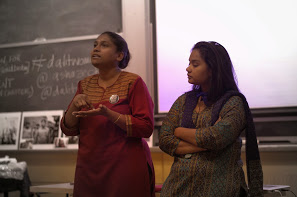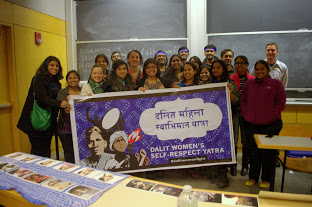Activists Asha Kowtal & Thenmozhi Soundararajan present
Dalit Self Respect March Reportback
Urge people to break the "deafening silence" over caste-Âbased violence against women in India
Asha Kowtal, General Secretary of the New Delhi, India, based All India Dalit Mahila Adhikar Manch (AIDMAM) and Thenmozhi Soundararajan, an activist and filmmaker based in New York presented a reportback to a full house at MIT on Apr. 20 on a self respect march they participated in India in FebÂ-Mar this year. The event was sponsored by Association for India’s Development (AID  MIT & Boston chapters) and the Ambedkar International Center.
Called the "Dalit Mahila Swabhiman Yatra" or the "Dalit Women's SelfÂDetermination March,†the journey covered the 4 states of Haryana, Delhi, UP and Bihar in north India and lasted about a month, from Feb 17 to Mar 12. Aimed to put "political pressure on officials, call out perpetrators and raise the continued cry for justice," the march was an expression of "issues regarding caste and women."
“We wanted to see how we can engage global solidarity to dismantle caste and patriarchy,†Soundararajan said.
"This is not a new situation for Dalit women in India," Soundararajan added, referring to the cases of sexual violence that has afflicted women of the lower caste."This is a war fought with bodies of Dalit women."
Beginning their presentation with a visual of caste hierarchy in India, Kowtal and Soundararajan explained that Dalits, which means "broken," were the former “untouchables,†regarded as outside the pale of the traditional four castes in Hinduism (the brahmins, the kshatriyas, the vaishyas and the shudras). They also drew linkages between these four castes and the control of resources  with the upper castes cornering the lion's share.
It is this hierarchy with Dalits at the bottom that also gives rise to a mindset of control towards women. "Caste and patriarchy operate together," Kowtal said. "The mindset of the upper classes is very clear  the lower social status of Dalit women is equal to their being of a low character," she added.
The idea of the march had its genesis in the gruesome incidents of violence against Dalit women in SepÂ-Oct 2012 in the north Indian state of Haryana. "It was a journey for justice to create a space for duty bearers and also provide space for survivors to reclaim their dignity," Kowtal explained.
"It was an emotive capacityÂbuilding process," Soundararajan added, "The Dalit women were making a statement that they would no longer be in darkness.†She further characterized their actions as the “flipping of the script to reclaim dignity.†“We realized we had to organize ourselves; the calling out of perpetrators had to be done by Dalit women,†she said.
Kowtal and Soundararajan described how they were taken care of at each of their halts on their journey by the Dalit community, who provided them hospitality. “We would start our day’s program at each stop by the Ambedkar statue which was a safe space for us,†she explained.
Kaushik Ragunathan, a postÂdoctoral student at Harvard University, asked about the intersections of caste and class, especially in urban India, and if such intersections result in the weakening of casteÂboundaries.
“In my mind there is nothing that is not linked with caste," Kowtal responded. "Each person has to examine and reÂexamine their own power and privilege Âthat is where our work has to begin."
Contact  Keerthana Krishnan
keerthana.krishnan@gmail.com
www.aidboston.org



